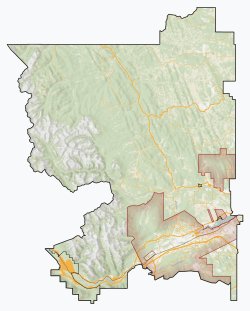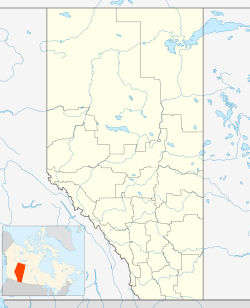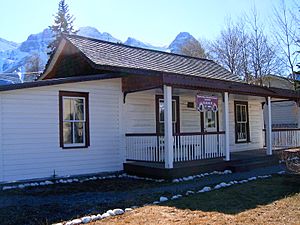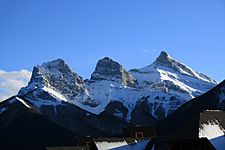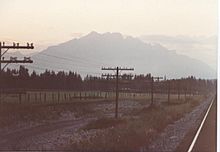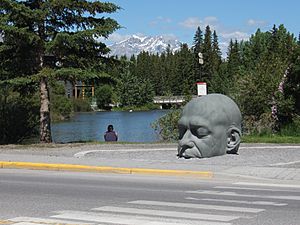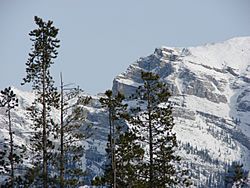Canmore, Alberta facts for kids
Quick facts for kids
Canmore
Chuwapchipchiyan Kude Bi (Stoney)
|
|||
|---|---|---|---|
|
Town
|
|||
| Town of Canmore | |||
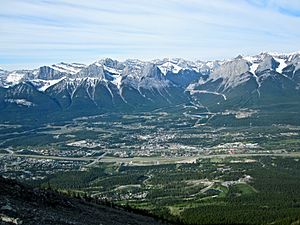
Canmore from Mount Lady Macdonald in May 2009
|
|||
|
|||
| Nickname(s):
Queen Town of the Rockies
|
|||
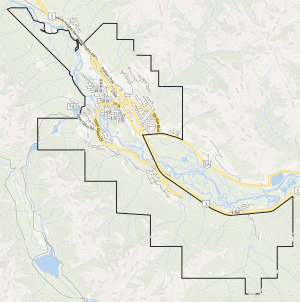
Town boundaries
|
|||
| Country | Canada | ||
| Province | Alberta | ||
| Region | Alberta's Rockies | ||
| Municipal district | Municipal District of Bighorn No. 8 | ||
| Adjacent Improvement districts | Improvement District No. 9 and Kananaskis Improvement District | ||
| Founded | 1884 | ||
| Incorporated | |||
| • Village | January 1, 1965 | ||
| • Town | June 1, 1966 | ||
| Area
(2021)
|
|||
| • Land | 68.47 km2 (26.44 sq mi) | ||
| • Urban | 12.96 km2 (5.00 sq mi) | ||
| Highest elevation | 1,480 m (4,860 ft) | ||
| Lowest elevation | 1,375 m (4,511 ft) | ||
| Population
(2021)
|
|||
| • Town | 15,990 | ||
| • Density | 233.5/km2 (605/sq mi) | ||
| • Urban | 13,268 | ||
| • Urban density | 1,023.7/km2 (2,651/sq mi) | ||
| • Municipal census (2014) | 13,077 | ||
| • Estimate (2020) | 14,798 | ||
| Time zone | UTC−7 (MST) | ||
| • Summer (DST) | UTC−6 (MDT) | ||
| Forward sortation area |
T1W
|
||
| Area code(s) | +1-403, +1-587 | ||
| Highways | |||
| Waterways | Bow River | ||
| Public Transit Service | Roam | ||
Canmore is a town in Alberta, Canada. It is about 81 kilometers (50 miles) west of Calgary. Canmore is located in the Bow Valley among Alberta's Rocky Mountains. It shares borders with Banff National Park and Kananaskis Country. In 2023, Canmore had a population of 17,036, making it the fifth-largest town in Alberta.
Contents
History of Canmore
How Canmore Got Its Name
Canmore was officially named in 1884. It was named by Canadian Pacific Railway director Donald A. Smith. The town was named after Malcolm III of Scotland, who was also known as Canmore. The name "Canmore" comes from the Scottish Gaelic words ceann mòr, which means "Big Chief."
Early Days and Coal Mining
In 1886, Queen Victoria gave permission for coal mining in Canmore. The first mine opened in 1887. By the 1890s, a North-West Mounted Police building was set up on Main Street. This building was later restored in 1989 and is now looked after by the Canmore Museum and Geoscience Centre.
The coal mining industry in Canmore grew a lot during the 20th century. In 1965, Canmore became an official town. By the 1970s, the demand for coal dropped. In 1979, Canmore Mines Ltd. stopped its operations. Most of the old mining buildings were taken down the next year. Only the lamp house and a few mine entrances remain today.
The Olympic Boost
Canmore's future looked uncertain after the mines closed. However, things changed when Calgary was chosen to host the 1988 Winter Olympics. Canmore became the site for the Nordic skiing events. This brought more tourists and helped Canmore become the popular outdoor destination it is today.
The Canmore Hotel
The Canmore Hotel was built in 1890 on the main street. In 2015, it was recognized as a heritage building and was renovated. The hotel celebrated its 120th anniversary in 2010.
Canmore's Indigenous Name
The Nakoda people know Canmore as Chuwapchipchiyan Kude Bi. There have been requests to make this an official name.
Geography of Canmore
Mountains and Scenery
|
Three Sisters Rocky Mountains viewed from Canmore, Alberta
|
Canmore is surrounded by beautiful mountains. Some of the famous mountains you can see from town include:
- Mount Rundle (2,949 meters / 9,675 feet)
- Mount Lawrence Grassi (2,685 meters / 8,809 feet)
- Three Sisters (2,936 m, 2,769 m, 2,694 m)
- Grotto Mountain (2,706 meters / 8,878 feet)
- Mount Lady Macdonald (2,606 meters / 8,550 feet)
Location and Transportation
Canmore is located along the Trans-Canada Highway and the Canadian Pacific Kansas City railway. The Bow River also flows through the town. These routes have helped Canmore's economy, which relies on tourism and its past mining industry.
Wildlife and Nature
A large part of the Canmore area is a wildlife corridor. This means it's a special path that animals like bears, cougars, wolves, and elk use to move safely between different areas. This helps them find food, avoid danger, and raise their young.
Canmore has many trails for hiking, mountain biking, and horseback riding. These trails are found in places like the Canmore Nordic Centre and along Mount Lawrence Grassi. Many trails are in Bow Valley Wildland Provincial Park and Kananaskis Country. Local groups and volunteers help maintain these trails.
Canmore's Climate
Canmore has a fairly mild climate compared to other parts of Alberta. Winters are not too cold, with an average high of -3.1°C (26.4°F) in January. Summers are short, with daytime temperatures usually between 18°C and 22°C (64°F and 72°F).
People of Canmore
Population Growth
Canmore's population has grown a lot over the years. In 2021, the town had 15,990 people living there. This was a good increase from its 2016 population of 13,992. Canmore is now one of the largest towns in Alberta. A town can become a city when it reaches 10,000 residents.
Languages Spoken
In 2016, about 81% of Canmore residents spoke English as their first language. About 5% spoke French, and 2% spoke German.
Economy of Canmore
Canmore's economy used to depend on coal mining. After the 1988 Winter Olympics, the town became a popular place for tourists and people looking for a second home. Now, its economy relies mostly on construction and tourism.
Arts and Culture in Canmore
Museum and Arts
Canmore has a museum called the Canmore Museum and Geoscience Centre (CMAGS). It looks after the town's history, artifacts, and old records. The museum also creates exhibits and programs for both locals and visitors.
The town is home to many writers, painters, and photographers. You can see the "Big Head" sculpture on Main Street.
Canmore on Screen
Many movies and TV shows have been filmed in the Canmore area. Some famous ones include Brokeback Mountain, The Last of Us, and Mystery Alaska.
Festivals and Events
Canmore hosts many fun festivals and events throughout the year:
- Canmore Uncorked: A food festival in April with special menus and cooking classes.
- 24 Hours of Adrenalin: A mountain bike race where riders compete for 24 hours at the Canmore Nordic Centre.
- Canmore Winter Carnival: A celebration of winter with ice carving, snow sculpting, and dog sled racing.
- Canmore Miners' Day Reunion: Held in July to remember the closing of the coal mines. It includes a parade and a picnic.
- The Canmore Folk Music Festival: A big music festival in August with many famous artists. It's the longest-running music festival in Alberta.
- Canmore Highland Games: Held in September, featuring Scottish traditions like heavy lifting, piping, and highland dance.
- Festival of Eagles: A celebration of the golden eagle migration over the Bow Valley.
- Vic Lewis International Band Festival: A music festival in November for school bands.
- Canmore Children's Festival: A two-day event with entertainment like acrobats, magicians, and storytellers for kids.
Attractions in Canmore
Elevation Place
Elevation Place opened in 2013. It is Canmore's modern recreation center. It has an 8-lane swimming pool, a world-class climbing wall, and fitness rooms. It also houses the community library and an art gallery.
Canmore Nordic Centre
The Canmore Nordic Centre was built for the 1988 Winter Olympics. It hosted cross-country skiing and biathlon events. Today, it offers world-class trails for cross-country skiers, mountain bikers, and hikers. It also has disc golf courses. The center is used for training by Canada's national ski teams and is open to the public. It has about 60 kilometers (37 miles) of trails, with some lit up for night skiing.
Grassi Lakes
The Upper and Lower Grassi Lakes are beautiful lakes located high in the Canadian Rockies. They get their water from natural springs and offer stunning views of Canmore.
Banff National Park
Canmore is very close to Banff National Park. The main entrance to the park is just northwest of town. It's a short 22-kilometer (14-mile) drive from Canmore to the town of Banff inside the park.
Sports in Canmore
Canmore is a great place for outdoor sports.
- Climbing: The area is popular for rock climbing and is a world destination for ice climbing.
- Water Sports: Kayakers and canoeists can explore the local rivers and lakes.
- Caving: The extensive Rat's Nest Cave is popular for caving.
- Mountain Biking: There's a large network of trails for mountain biking.
Hockey
Canmore has a junior hockey team called the Canmore Eagles. Famous hockey players like Dan Blackburn and Brayden Point have played for the Eagles. The hockey movie Mystery, Alaska was filmed in Canmore.
Skiing and Biathlon
Canmore is the official home for Canada's national cross-country skiing and biathlon teams. Many athletes train here year-round.
- In 2006, Canmore's own Chandra Crawford won a gold medal in cross-country skiing at the Winter Olympics.
- Beckie Scott, a gold medalist from the 2002 Winter Olympics, also lives in Canmore.
The Canmore Nordic Centre hosts many big sporting events, including international mountain bike races and World Cup cross-country ski races.
Other Sports
- Soccer: Canmore United is a popular local soccer team.
- Skate Park: The Canmore Youth Skate Park was built in 2009.
Media in Canmore
The main newspapers in Canmore are the Rocky Mountain Outlook and the Bow Valley Crag and Canyon. The local radio station is CHMN-FM, which plays adult contemporary music.
Housing in Canmore
Canmore is a beautiful place to live, but finding affordable housing can be challenging. The town has worked on several projects to help. The Canmore Community Housing Corporation (CCHC) helps provide affordable homes for people in the community.
Infrastructure
- Healthcare: Health care services are available at the Canmore General Hospital.
- Public Transit: Roam transit provides public transportation in Canmore.
Notable People from Canmore
- Paige Cooper, Canadian writer
- Brian McKeever (1979), paralympic skier and biathlete, Olympic medalist
- Chandra Crawford (1983), cross-country skier and Olympic gold medalist
- Sarah Murphy (1988), biathlete
- Rosanna Crawford (1988), biathlete
- Tristan Tafel (1990), freestyle skier
- Macx Davies (1992), biathlete
- Connor Howe (2000), speed skater
- Percy Jackson (1906–1972), ice hockey goaltender
Films Shot in Canmore
- The Last of Us
- Mystery, Alaska (hockey movie)
- Last of the Dogmen
Images for kids
-
Three Sisters Rocky Mountains viewed from Canmore, Alberta
See also
 In Spanish: Canmore para niños
In Spanish: Canmore para niños



